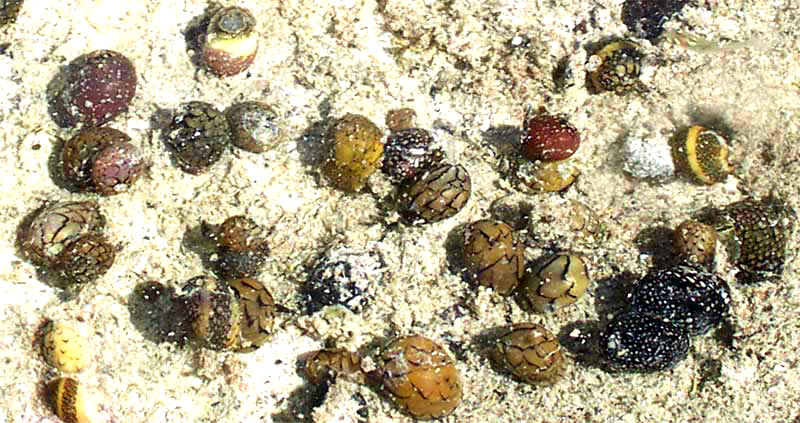Excerpts from Jim Conrad's
Naturalist Newsletter
from the November 20, 2006 Newsletter issued from Rio Lagartos, Yucatán, MÉXICO
NERITES IN THE MANGROVES
The other day Tom Eichhorst in New Mexico wrote to comment on something I'd written. At the end of his letter his signature revealed that he was the Editor of the American Conchologist, a journal dealing with what most people call seashells. I ended my reply to Tom by saying something like "I wish I had a conchologist down here because I'm seeing a remarkable community of snails or snail-like creatures at the water's edge in the mangroves, and some of the shells are amazingly ornate."
Tom wrote back admitting that he was an expert on just such organisms and he invited me to send photos for identification. Immediately I set off into the mangroves and photographed what I assumed to be at least half a dozen snail species. You can see one such photo below.

The organisms shown above are submerged in about ¼-inch of clear water (see the fish in the upper, right corner?). Notice how some shells are black with white speckles, others are tan with zigzagging black lines, others are reddish with white dots, some have banding, etc. How many species would you estimate to be there?
Imagine my astonishment when Tom wrote back saying they were ALL "Virgin neritinas," NERITINA VIRGINEA. They are a special kind of snail known as a "nerite," belonging to the Nerite Family, the Neritidae, which embraces over 280 mostly tropical and sub-tropical coastal species.
Tom told me a lot about nerites, including this: They come in male and female organisms, the male having a penis near his right eye and tentacle. Despite their small size (about like peas) traditionally they served as a major food item for indigenous people, and still do in some underdeveloped countries. My Virgin neritinas (not virgins at all) have a life span of only two to three years, though most nerites live about five years, and one has been recorded surviving for over 20 years.
Finally, nerites possess a hard calcium "trap door" or operculum with which they can seal the hole from which their bodies extend from their shells. These doors protect the snails' soft parts, plus our intertidal- dwelling species can use them to seal in water while being exposed on rock surfaces during low tides. They can even slowly release small amounts of water around the operculum's edges to provide evaporative cooling.
Our Virgin neritinas are distributed from along the US Gulf Coast all through the Caribbean and along the South American Atlantic coast to central Brazil. In a paper Tom is about to publish he describes their habitat as "Brackish: on and under stones and vegetation in rivers and streams, especially near the mouth. Not found upstream of a point influenced by high tide or wave action." Mine were in the mangroves where saltwater poured into and out of the swamps through a cement culvert beneath a road.